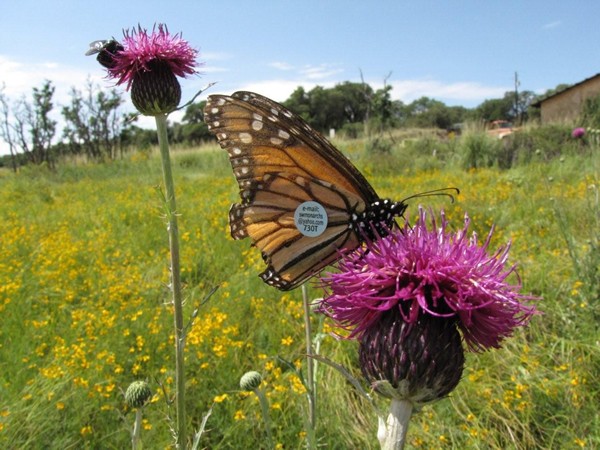Letter from Gail Morris: Western Monarch Spring 2022 Report #5
Published: 04/27/2022
Dear Western Monarch Friends,
Many community scientists reports were filed this week in a variety of categories offering us a multidimensional snapshot of the spring migration in progress across the Southwest. Soon these long-lived, aged adult monarchs will reach the end of their lifespan but there will be a trail of eggs and immatures left behind. We’ll see a lull in sightings until a new generation ecloses. Be sure to check nearby milkweed thickets for hidden monarch eggs, larvae and pupae.
Western Monarch Sightings
Adult and immature monarch reports increased this week. Here is a sample of the findings:
Theresa reported one monarch larva in Brea, California on April 9. “Monarch caterpillar [sic] preparing to pupate! Silk pad in place.”
Monarchs lay eggs on milkweed before it is in flower. Michael found two eggs right on the milkweed flower buds on April 10 in Palm Springs, California. “Observed large female with bright colored wings, fresh appearance laying eggs on desert milkweed.” Desert Milkweed is also known as Rush Milkweed, A. subulata.
Even when you are out having fun you can spot a monarch! Alma saw her first of year monarch in Buena Park on April 11. “We sighted a monarch while riding the train in camp snoopy.”
On April 13 Michael spotted 3 larvae in Palm Springs, California. “Instar 3-4, feeding on desert milkweed.”
Sandra in Lakeside, California saw her first of year monarch on April 19. “Nectaring in our front yard. No signs yet of eggs on the milkweed out back.”
Joyce reports 17 monarchs this week on April 23 at Mountain View, California. “Sunny spring day in the upper 60's at Google yesterday. The monarchs were very active, mostly flying up and down the road lined with trees, wildflowers and milkweed. We saw this old faded and tattered male nectaring on a tropical milkweed. Amazed at how close he allowed me to get to him with my iPhone.”
Milkweed Up?
For a good breeding season, monarchs need milkweed and flower nectar for energy to sustain their flight. Some people are wondering if there is a phenology mismatch for monarchs. In other words, are some monarchs extending their range into new areas before the milkweed has broken ground? Last week we shared reports of milkweed up in Salt Lake City, Utah, ahead of the migration. Where else?
On April 12, Renee sighted milkweed in Corrales, New Mexico. “Horsetail milkweed in my garden.”
James in Las Cruces, New Mexico, reported his first sighting of milkweed on April 17. “Horse/Poison/Whorled Milkweed emerging from 1"-2" thick litter and ~2"-3" tall in this image. A few emerging stems were in the 4"-6" range. It is likely that the first above-ground emergence occurred perhaps two-three weeks prior at this site along an irrigation ditch from the Rio Grande. It is near La Llorna City Park, Las Cruces, NM. Milkweed stands ~1.5 miles further south on the bank of the Rio Grande, and with a litter layer 8"-12" deep (mostly from Bermudagrass), were not yet showing milkweed stem/leaf emergence when a few old stem bases from 2021 were exposed.”
Let us know if you see any milkweed up your way!
Send in your reports!
If you are lucky enough to see monarchs on their Spring Migration, be sure to report them to Journey North—whether they are adults or eggs or larvae. Provide as much information as you can such as weather conditions (it’s okay to estimate). Your detailed description of what you see can include, but is not limited to, the monarch’s gender and activity and, if known, the type of flowers if they are nectaring. If you can, observe the condition of the wings—fresh and new or worn and tattered or something in between. This helps us learn more about monarch age and survival. We realize it isn’t always possible, but please take a photo if you can. Thanks so much for your help.
Gail Morris is the Coordinator of the Southwest Monarch Study (www.swmonarchs.org), a Monarch Watch Conservation Specialist, and the Vice President of the Monarch Butterfly Fund, the Central Arizona Butterfly Association and the Western Monarch Advocates. The Western Monarch Population News is based on comments provided to Gail Morris. We hope to increase the number of sightings and therefore photos and comments entered into Journey North. We rely on the volunteers who communicate regularly with Gail and who agree to participate in our effort to increase awareness of the population of western Monarchs. You can reach her at gail@swmonarchs.org







